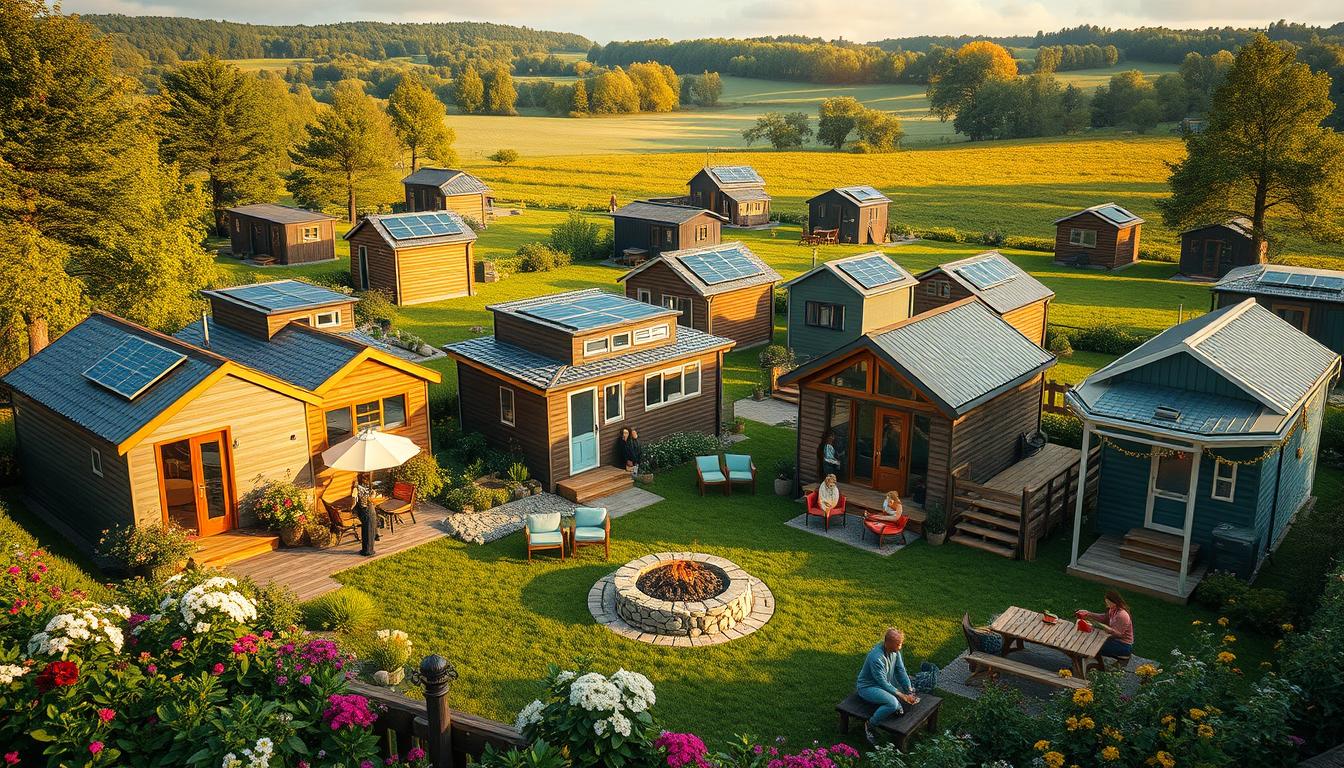Did you know tiny houses in the UK use only 20 to 30% of the energy of a regular home? This shows how efficient tiny homes co living is. It’s a trend changing how we live together in the UK.
In the UK, where housing costs keep rising, tiny homes co living is becoming popular. It’s a way to live sustainably. These small homes offer private space and shared facilities.
These tiny homes are built to be very energy-efficient. They have features like triple glazing and great insulation. This can cut energy bills by up to 80%, saving £3,000 to £5,000 a year.
Living in tiny homes co living is more than saving money. It’s about living simply and sustainably. Communities have shared gardens and workshops. This creates a sense of belonging, something often missing in big cities.
Key Takeaways
- Tiny homes use 20-30% of the energy of average UK houses
- Energy-efficient features can save residents up to £5,000 annually
- Co-living communities promote sustainable living practices
- Shared amenities foster a strong sense of community
- Tiny homes offer a solution to rising housing costs
- The concept combines private living with communal benefits
Understanding the Rise of Tiny Home Communities in Britain
The UK’s housing market is facing big challenges. The average house price is now £290,000. First-time buyers often need £50,000 for a deposit. Tiny home communities are becoming more as a new solution.
The Evolution of Minimalist Living
Compact dwellings represent a minimalist lifestyle. They are small, ranging from 100 to 400 square feet. This encourages sustainable living and less waste. In Britain, people are drawn to tiny homes for their affordability, eco-friendliness, and the ability to move easily.
Current Housing Market Challenges
Urban growth has led to the loss of 54,000 acres of green space from 2006 to 2012. Tiny homes offer a different option, costing between £30,000 and £100,000. This is much cheaper than traditional homes, making it easier for many to own a home.
| Housing Type | Average Price | Carbon Footprint |
|---|---|---|
| Traditional Home (England) | £315,000 | 100% |
| Traditional Home (Scotland) | £191,000 | 100% |
| Tiny Home | £30,000 – £100,000 | 9% |
Community-Focused Solutions
Tiny home communities offer shared facilities and a sense of belonging. They have eco-friendly features like solar panels and composting toilets. Residents can save £780-£1,057 a month and enjoy a supportive community with neighbours who share similar values.
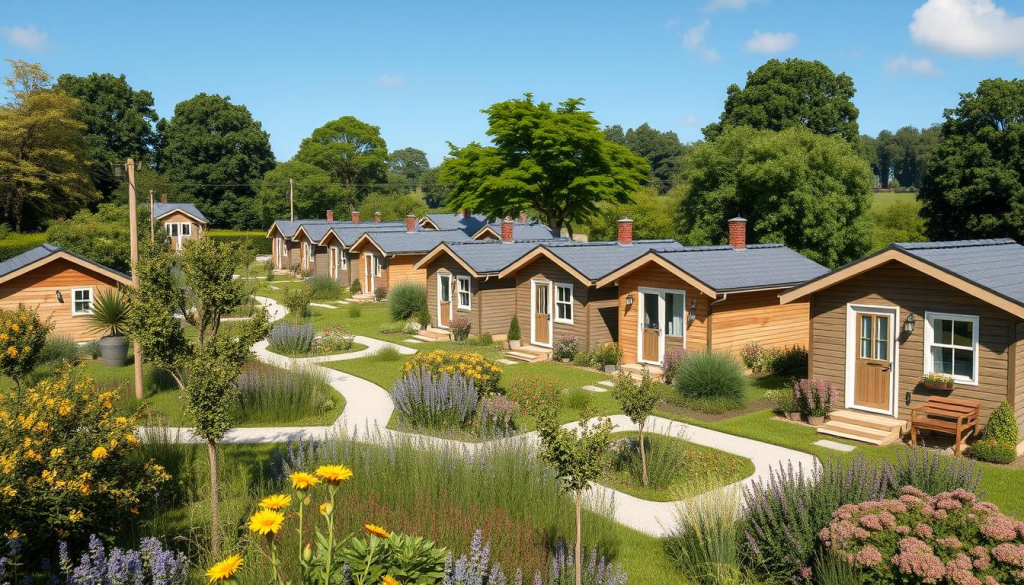
The tiny home movement is growing. It tackles housing affordability, supports sustainable living, and builds tight-knit communities. More and more Britons are choosing this lifestyle, changing the UK’s housing scene.
What Makes Tiny Homes Co Living Different?
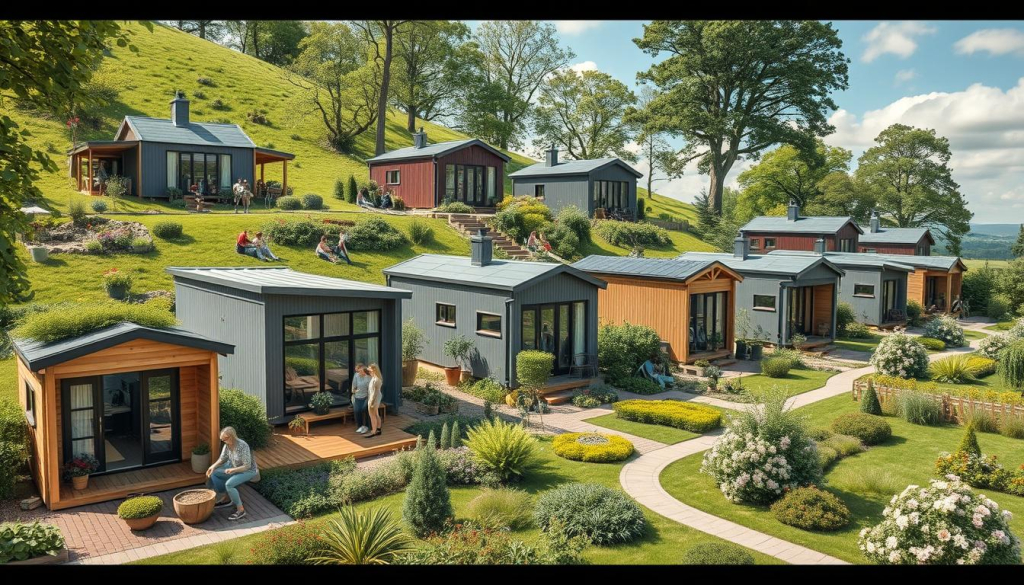
The tiny house movement in the UK is growing fast. It offers a new way to downsize homes. Tiny homes co living combines small living with a strong community feel. This is a big change from traditional housing, especially in cities where homes are very expensive.
These homes are designed for both privacy and sharing. They cost between £25,000 and £60,000. This is much cheaper than regular homes. For example, in London, a one-bedroom flat can cost over £2,000 a month to rent.
At the heart of tiny homes co living are collaborative spaces. A project in Bristol aims to fight loneliness by building a supportive community. It includes shared areas like:
- Community courtyard
- Public foraging route
- Shared kitchen facilities
- Arts trail
These spaces encourage people to come together. Young people, in particular, value experiences over owning things. Over 20% of 18-34 year olds live in cities in the UK.
| Feature | Traditional Housing | Tiny Homes Co Living |
|---|---|---|
| Average Cost | £250,000+ | £25,000 – £60,000 |
| Community Focus | Limited | High |
| Shared Amenities | Rare | Abundant |
| Environmental Impact | Higher | Lower |
Tiny homes co living is more than just downsizing. It’s about building a connected and sustainable life in the UK.
Sustainable Features and Eco-Friendly Design
Tiny homes co living spaces lead the way in sustainable living. They have many eco-friendly features. These homes use less energy and are designed for comfort and function.
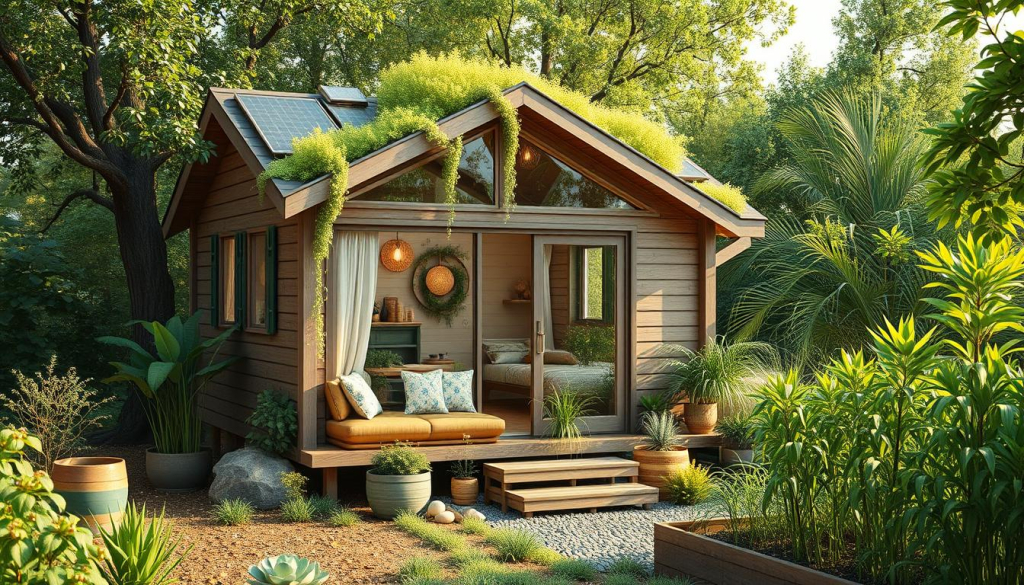
Triple Glazing and Superior Insulation
Triple glazing and top-notch insulation are key in these homes. They cut down on energy loss and noise. This makes the homes cozy all year round.
They also save on heating and cooling costs. This makes living in these homes more budget-friendly over time.
Air Source Heat Pumps and Energy Recovery
Tiny homes use air source heat pumps and heat recovery systems. These systems keep the temperature steady while using less energy. They help save energy by reusing heat.
Water Conservation Systems
Water saving is a big deal in tiny home design. These homes can use up to 40% less water. This helps reduce their environmental impact.
Using natural materials and non-toxic paints also helps. It cuts down indoor pollution by 75% and VOCs by up to 75%. This makes tiny homes great for healthy living.
“Tiny homes reduce per-person carbon emissions by 70 percent over the lifespan compared to a traditional home.”
These homes are a smart choice for the environment. They offer a way to live more sustainably and reduce our impact on the planet.
The Economics of Tiny Home Living
Tiny home living is changing how we think about affordable housing and saving money. It’s becoming more popular in the UK housing market.
Buying a tiny home costs much less than a regular house. For example, WikiHouse, an open-source building system, can cut construction costs by up to two-thirds. This makes it easier for young people and first-time buyers to own a home.
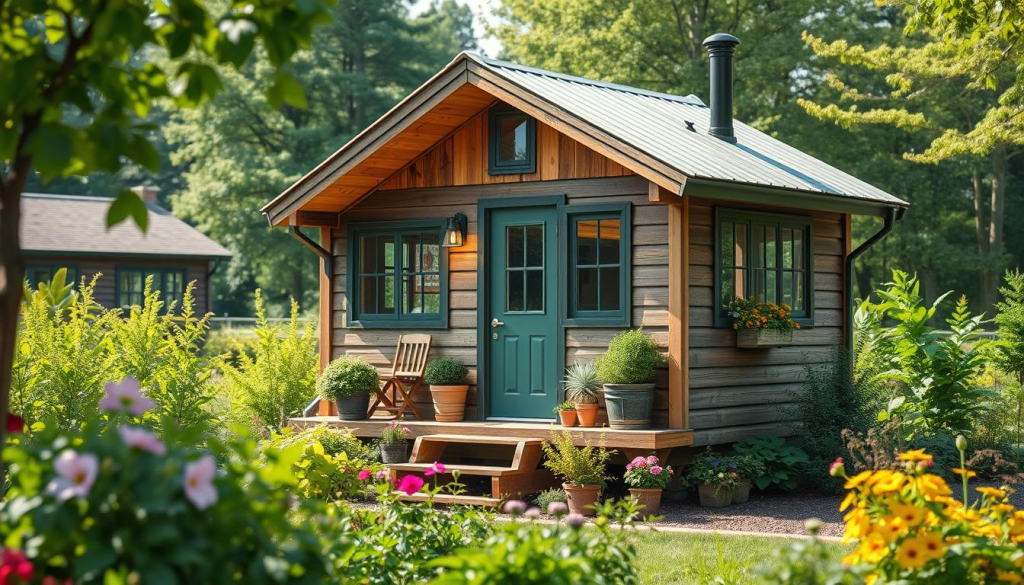
Living in a tiny home can save a lot on energy bills. Some people see their bills drop by up to 80%. It also means less money spent on upkeep because the home is smaller.
Some tiny homes, like the ‘Hampstead’, are fully furnished and can fit up to six people. This is great value. Going off-grid can also save money in the long run, adding to the financial benefits.
| Aspect | Traditional Home | Tiny Home |
|---|---|---|
| Initial Cost | £250,000+ | £30,000 – £80,000 |
| Energy Bills (Monthly) | £100 – £150 | £20 – £30 |
| Maintenance (Annual) | £1,000 – £3,000 | £200 – £500 |
| Property Tax | Higher | Lower or Exempt |
Even though tiny homes might lose value, they’re a chance for millennials to get into the property market early. Many see tiny living as a way to own a home now and save for a bigger one later.
Community Amenities and Shared Spaces
Tiny homes co living communities in the UK are changing the way we live. They offer collaborative living spaces with new ideas. They mix private and shared areas, meeting the need for community housing.
Common Areas and Social Hubs
At the centre of these communities are lively social hubs. These areas are made for people to meet and chat. You’ll find:
- Cosy lounges for relaxing and socialising
- Shared workspaces for those who work from home
- Communal kitchens for meals and cooking classes
Shared Gardens and Outdoor Spaces
Outdoor spaces are key to a good living experience. Many tiny home communities have:
- Courtyard gardens for quiet moments
- Community allotments for growing food
- Natural play parks for kids
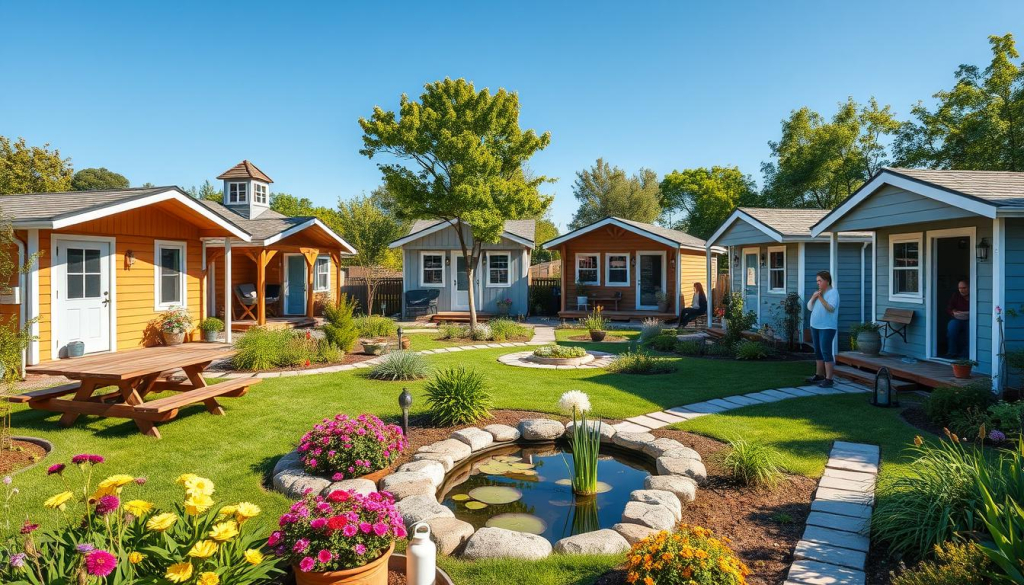
Community Facilities
These places also have many facilities to help people feel at home and well:
| Facility | Purpose | Benefits |
|---|---|---|
| Fitness Centre | Physical health | Exercise options right there |
| Art Studio | Creative expression | Projects to work on together |
| Community Café | Social interaction | A place to meet up |
These shared spaces not only save space but also help people connect. They make it easy to form strong bonds in community housing.
Modern Design and Space Optimisation
In the UK, more people want to live in small spaces because of city life and crowded areas. Tiny homes co-living offers smart ways to use little room. Let’s see how these homes mix style with usefulness.
Innovative Storage Solutions
Vertical storage changes the game in tiny homes. Shelves and wall units turn empty walls into great spots for storing things. These custom designs not only look good but can also increase a home’s value.
Multi-functional Furniture
Space-saving design is key in tiny home living. Furniture that does more than one thing helps solve space problems. From sofa beds to extendable tables, these items add a twist to usual furniture and use every inch wisely.
Smart Technology Integration
Smart home tech is vital for tiny living. It controls lights, heat, and security, making life easier and more efficient. It also helps save on bills, making small living green and cost-effective.
| Feature | Benefit |
|---|---|
| Vertical Storage | Maximises wall space, keeps items organised |
| Multi-functional Furniture | Serves multiple purposes, saves space |
| Smart Home Tech | Enhances comfort, improves energy efficiency |
With these features, tiny homes feel big and stylish, even though they’re small. The focus on new design and smart solutions means people can live comfortably without giving up on looks or function.
Legal Considerations and Planning Permission
Understanding tiny house regulations and planning laws in the UK can be challenging. Tiny homes on wheels (THOWs) are often seen as caravans. This means they have some freedom but also face certain rules.
The Caravan Sites and Control of Development Act 1960 lets you park a THOW in your driveway. But, it must not be used as a separate home.
THOWs must also follow size rules for the road. They can’t be wider than 2.55m or longer than 7m if you have a standard licence. Not following these rules can lead to fines.
There are more rules for tiny homes beyond size. Local councils can stop a THOW if they think it looks out of place. Also, you might have to pay Council Tax if it’s your main home.
Planning permission is usually needed for tiny homes as full-time homes. But, there are some exceptions. For example, tiny houses can go in back gardens without permission if they’re not too big and are extra living space.
| Aspect | Requirement |
|---|---|
| Max Width (Road Legal) | 2.55m |
| Max Length (Standard Licence) | 7m |
| Max Size (No Planning Permission) | 19.8m x 6.7m |
| Council Tax | Applicable if main residence |
The Social Impact of Tiny Homes Co Living
Tiny homes co living is changing how we live together in the UK. It’s a new way to address today’s social issues. This housing model is becoming popular for its role in building strong communities and connections.
Combating Loneliness
Loneliness is a big problem today. Tiny home communities offer a solution. They are designed to bring people together, creating chances for real connections.
Shared spaces and activities are key. They help people feel part of something bigger than themselves. This is something many miss in regular homes.
Building Supportive Networks
Tiny home communities are more than homes. They are vibrant ecosystems of support. People share resources, skills, and time, building strong networks.
This way of living eases individual burdens. It also makes communities stronger.
Multi-generational Living Benefits
One special thing about tiny home co living is multi-generational living. It helps families stay close and support each other. This is a modern take on old family values.
This living style also helps society. It supports sustainable living and uses fewer resources. A study suggests it could cut resource use by 85% per person.
“Tiny home living is not just about reducing space; it’s about expanding our capacity for connection and mutual support.”
As the UK deals with housing issues, tiny homes co living is a hopeful answer. It’s not just about affordable homes. It’s about building places where people can connect and support each other.
Cost Comparison with Traditional Housing
Tiny homes co living is a cost-effective choice compared to traditional housing. It offers a significant reduction in housing costs. This makes it appealing to those wanting to save money.
Initial Investment Analysis
The cost of a tiny home is much lower than a traditional house. In the UK, a basic tiny home costs between £15,000 and £40,000. Meanwhile, the average house price is £288,000. This big difference in cost makes tiny homes more accessible for many.
Long-term Savings Potential
Tiny homes save a lot of money in the long run. Their small size and efficient design mean energy bills can be as low as £40 a month. Adding solar power can save another £1,200 a year.
Maintenance Costs
The small size of tiny homes means lower maintenance costs. Owners spend less on repairs and renovations. This helps save a lot of money over time.
| Expense Category | Tiny Home | Traditional House |
|---|---|---|
| Initial Cost | £15,000 – £40,000 | £288,000 (average) |
| Monthly Energy Bill | £40 (approx.) | £100 – £150 |
| Annual Maintenance | £500 – £1,000 | £2,000 – £5,000 |
While tiny homes have many financial benefits, it’s important to think about land costs and resale value. Still, the savings make tiny home living a great choice for affordable living in the UK.
Environmental Impact and Sustainability Metrics
Tiny homes co-living is all about living green and cutting down on carbon. It’s changing the UK’s housing scene, offering a more eco-friendly option than usual homes.
Studies show co-living spaces are better for the planet than regular apartments:
- They save 10-20% in embodied carbon at the building level
- Carbon savings per person are 21-36%
- They use resources better with shared spaces and facilities
- By 2020, global building emissions hit 14 Gt, up from 1990
- UK folks need 2.6 Earths to live their lifestyle, showing we consume too much
- Construction materials are set to double by 2060 if we keep doing things the same way
Tiny homes co-living helps meet sustainability goals by:
- Smaller homes mean less space per person
- Using fewer resources like energy, materials, and water
- Turning old buildings into new homes
The small size and shared areas in tiny homes make land use more efficient. This fits well with living green and building sustainable communities.
| Feature | Environmental Impact |
|---|---|
| Shared Spaces | Less resource use per person |
| Compact Design | Less land needed and lower carbon footprint |
| Sustainable Materials | Less harm to the environment in building |
| Energy-Efficient Systems | Less energy used and fewer emissions |
Conclusion
Tiny homes co living is a new way to solve the UK’s housing problems. It offers a fresh look at living together sustainably. This approach makes homes affordable and good for the planet, creating a sense of community among residents.
These homes are small, from 9 to 37 square metres. They use less energy than big houses. They also cost less, making it easier for people to buy a home.
Living in tiny homes is more than just saving money. It creates a special community feel. People share spaces and work together, fighting loneliness in cities.
In the UK, tiny homes co living is a smart choice for housing. It tackles shortages and environmental worries. By choosing this path, we build a more connected and green future for our communities.


